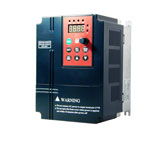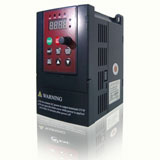Increase the speed of a motor by VFD
Motors generally have to withstand 10 % overspeed. But it in no way means many motors cannot withstand much higher over speeds.
For example - a 2.2 kW 8 pole motor (750 or 900 r/min rated speed depending on frequency bring 50 or 60 Hz) will use the same bearings and rotor construction as a 5 kW 2 pole motor (3000 or 3600 r/min sync speed for 50 or 60 Hz).
This means that one could happily operate the 2.2 kW 8 pole motor at 400 % speed - with constant power operation of course - not constant torque.
There are three factors to consider when operating a motor at increased frequency: Will the rotor break apart; will the bearings overheat?; and will the load be happy with constant power operation? (I.e. Reduced torque).
In general - small 4 pole motors will easily manage 200 % overspeed operation CONTINUOUSLY. 8 pole small motors can run to 4 times rated speed for constant power operation. One needs to take a little more care with 2 pole small motors because these are already at the limit of standard design factors.
My suggestion: Look at the bearing types and check their speed ratings in bearing catalogues. They should run without problems at speeds up to 2/3 of their speed ratings.
The rotor breaking up is a little more complicated but look at the physical size of 2 pole motors in the same range - at the maximum power point - and extrapolates what is possible with the motor you're considering, assuming you know the rotor outside diameter.
There are of course exceptions (for example - make sure you never run continuously on a critical speed), and larger motors need to be considered case by case.
Some specially designed motors meant for use with VFDs are designed to operate at higher than normal speeds at frequencies above 60 hertz.
Increasing frequency above 60 hertz makes the motor run faster than normal and creates two primary concerns:
1. Was the motor or the load it drives designed to operate at these increased speeds?
Many motors and devices were not mechanically balanced to operate at increased speeds and will create vibration, mechanical and safety problems.
2. VFDs are not capable of increasing voltage so as frequency increases above 60 hertz, the torque produced starts to decrease.
In order to maintain a constant horsepower output to drive our load, if speed is increased, torque must decrease.
At some point of increased speed we may not be able to produce enough torque to drive the load and at this point, the motor will slow even with increasing frequency.
For example - a 2.2 kW 8 pole motor (750 or 900 r/min rated speed depending on frequency bring 50 or 60 Hz) will use the same bearings and rotor construction as a 5 kW 2 pole motor (3000 or 3600 r/min sync speed for 50 or 60 Hz).
This means that one could happily operate the 2.2 kW 8 pole motor at 400 % speed - with constant power operation of course - not constant torque.
There are three factors to consider when operating a motor at increased frequency: Will the rotor break apart; will the bearings overheat?; and will the load be happy with constant power operation? (I.e. Reduced torque).
In general - small 4 pole motors will easily manage 200 % overspeed operation CONTINUOUSLY. 8 pole small motors can run to 4 times rated speed for constant power operation. One needs to take a little more care with 2 pole small motors because these are already at the limit of standard design factors.
My suggestion: Look at the bearing types and check their speed ratings in bearing catalogues. They should run without problems at speeds up to 2/3 of their speed ratings.
The rotor breaking up is a little more complicated but look at the physical size of 2 pole motors in the same range - at the maximum power point - and extrapolates what is possible with the motor you're considering, assuming you know the rotor outside diameter.
There are of course exceptions (for example - make sure you never run continuously on a critical speed), and larger motors need to be considered case by case.
Some specially designed motors meant for use with VFDs are designed to operate at higher than normal speeds at frequencies above 60 hertz.
Increasing frequency above 60 hertz makes the motor run faster than normal and creates two primary concerns:
1. Was the motor or the load it drives designed to operate at these increased speeds?
Many motors and devices were not mechanically balanced to operate at increased speeds and will create vibration, mechanical and safety problems.
2. VFDs are not capable of increasing voltage so as frequency increases above 60 hertz, the torque produced starts to decrease.
In order to maintain a constant horsepower output to drive our load, if speed is increased, torque must decrease.
At some point of increased speed we may not be able to produce enough torque to drive the load and at this point, the motor will slow even with increasing frequency.



